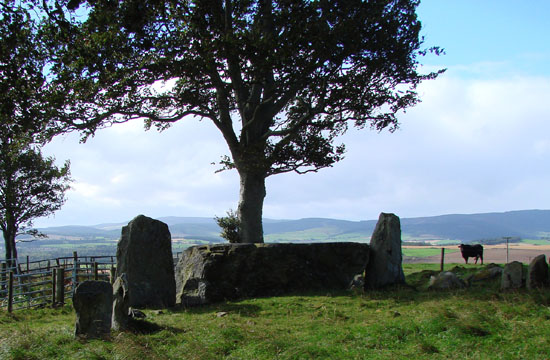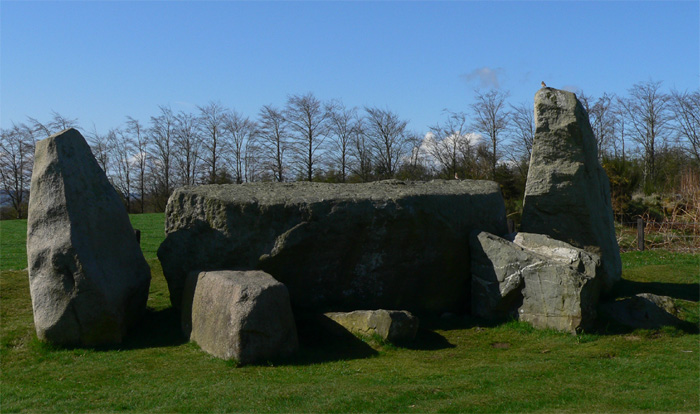 Recumbent Stone Circles:
(R.S.C's)
Recumbent Stone Circles:
(R.S.C's)
What makes
these circles unique is the large 'recumbent' stone (often
several tonnes in weight) which lies horizontally between two
large 'flankers'. This is the recumbent. Typically the stones
which made up the circle were graded so that they decreased in
size away from the recumbent. The recumbent stone is invariably
placed south-west of the circle or in the southern arc of the
ring.
Research has
shown that the orientation and the length of the recumbents
suggests that they were meant as a 'frame for viewing the rising
and setting of the moon at certain times'
What may be the
earliest primitive version of a recumbent Stone Circle was
identified in 2013 in the shape of a 10,000 year old arc of
wooden post holes mirroring the function of the recumbent and
flankers. The location of the monument places it in the same
region, as the largest concentration of RSC's, which all lie on
a latitude which offers a narrow distance between the moons
extreme setting points, such that they can be easilty framed.
Statistical analysis has shown that they have a clear
association to prehistoric lunar observation.
In Aberdeenshire, with a mean
latitude of 57� 30's, the moon at its maximum, will rise at 155�
SSE, and set at 205� SSW. Of the 48
recumbents where it is possible to plot their
axis, 45 have recumbent between these limits. The remaining were placed at 230�,
231� and 232�, the min moon setting.
(Ref: Burl. Stone circles).
Article:
(BBC: July,
2013).
'Earliest
Lunar Calendar found in Scotland c. 8,000 BC'.
'Excavations of
a field at Crathes Castle found a series of 12 pits
which appear to mimic the phases of the moon and track
lunar months. The pit alignment aligns on the Midwinter
sunrise'.
(Link
to Full article)
The earliest
Recumbent stone circles (RSC's) are believed to date from
around 3,000 BC (4)
but they continued being constructed from the Neolithic to the
Bronze age c.1,500 BC
Recumbent Stone
circles are found predominantly in Aberdeenshire, north-east
Scotland, but they are also evident in south-west Ireland, where
instead of being designed to observe the 'Lunar' cycles, they
were designed for Solar observation. (Drombeg stone circle near
Glandore and Rosscarbery, Co. Cork).
In both cases,
the recumbent stone is generally found on the south-western side
of the circle. In the Scottish circles it is large and set
between two tall uprights, known as flankers, that are normally
the tallest stones in the circle. The heights of other stones
tend to taper away as one goes round the circle, so that the
smallest are found on the opposite, or north-eastern, side. In
the Irish circles, on the other hand, the tapering works in the
other direction; the recumbent stone is small and placed in
isolation, and the tallest stones are normally a pair called
portals on the opposite north-eastern side.
Aberdeenshire Recumbents:
The Recumbent Stone Circle (RSC) is Aberdeenshire's
unique contribution to the tradition of erecting rings
of standing stones which was current in certain parts of
Britain and Ireland during the third and second
millennia BC. Their place, function and role in
prehistoric society has been variously speculated
on, with ideas ranging from sacrificial altars to
the now conclusively proven association with
astronomy.

Over a hundred examples have been recorded, with diameters
ranging from 18.2 m to 24.4 m.
The distinctive feature of the RSC is the massive
slab, laid recumbent on its side in the south-western or
southern arc of the ring, and flanked by the two tallest
stones of the circle. The recumbents average 24 tons in
weight and were carefully levered and chocked-up to
ensure that their upper surface was as level as
possible.
The
Stone Recumbents and their flankers were carefully
chosen and are generally of a different composition and
colour to the rest. At Easter Aquhorthies, a few miles
west of Inverurie, most of the stones are of pinkish
porphyry but one is red jasper. They contrast with the
light grey of the granite flankers and the red granite
recumbent.
'There is also an association between
recumbent stone circles and Scottish carved
stone balls � echoing the carved chalk balls
found at and around Stonehenge. Carved stone
balls originate in Orkney and Aberdeenshire, and
are associated with a style of pottery called
Grooved Ware, which spread southwards throughout
Britain. Most carved stone balls have geometric
patterns of grooves carved across their surface,
depicting a series of shapes known as the
Platonic Solids or compound polyhedra. The
number of bosses carved on the balls demonstrate
these Neolithic people were able to count and
use complex geometry. Recumbent stone circles
and carved stone balls suggest that a group of
people in north-east Scotland and Orkney were
conversant with mathematics, geometry and
astronomical alignments in a pre-literate
context'. (3)
(More
about The Scottish Stone Balls)
Irish
Recumbents: Also
called 'Axial Stone Circles (ASLs)
It is interesting to note that the only
recumbent circles found outside of Scotland, are in the Ross-Carbery area of
Ireland (SW), which places them too far south to make them any use as lunar
observatories, and have in fact been shown to be solar in their
orientation. Cope (4), makes note of the
Drombeg RSC, where the sun has been observed setting at midwinter
(solstice), directly into a notch in the landscape behind the recumbent
stone.
Drombeg, Co
Cork: Of the original 17 pillars of smooth-sided local
sandstone erected in a circle of 9.5m (31ft) in diameter,
only 13 remain. To the left of the north-east entrance is a
portal stone 2.2m (7ft 2in) high; its opposite is the 1.9m
(6ft 10in) long recumbent which has two egg-shaped cup-marks
(one with a ring around it). The circle stones have been
shaped to slope upwards to the recumbent itself. The
midpoint of this stone was set in line with the winter
solstice sunset.
(More
about Drombeg)
Bohonagh,
Co. Cork: Is comprised of 13 stones set in a circle (13
lunar months) with a diameter of 30 ft. Four out of the 13
stones are missing and three were re-erected after
excavation. Two portal stones are set radially on an
east-west axis to the recumbent stones and are 240 cm high.
At just under 8 ft, these stone are among the tallest of any
Irish stone circle. The axis from these stones to the large
axial-stone on the west side, points to sunset at the
equinoxes. Many of the stones have quartz inclusions and
many small pieces of quartz are associated with the circle.
It is believed that the recumbent and flanking stones
form a kind of false horizon or frame through which to
view the rising or setting of the major standstill moon
that occurs every 18.6 years. At that point, the moon
dips towards the recumbent. On 12 of the RSCs,
decoration in the form of cup-marks (cup-shaped hollows
between 10 and 50 mm in diameter) have been found,
clustering at points (the recumbent, flankers or
immediately adjacent stones) where the major standstill
moon rises or sets.
(1)
Their almost invariable function as
'lunar' calendars is one of the best evidences we have that
Neolithic people were aware of the 18.6 year lunar cycle and
observed it closely. It is now suggested that these RSC's were
replicas of earlier Neolithic constructions.
(5)
In Aberdeenshire, with a mean
latitude of 57� 30's, the moon at its maximum, will rise at 155�
SSE, and set at 205� SSW. Of the 48
recumbent's where it is possible to plot their
axis, 45 have recumbent between these limits. The remaining were placed at 230�,
231� and 232�, the min moon setting. (Ref: Burl. Stone circles).
The latitude of the Aberdeenshire recumbents
is such that the moon would have appeared to
'roll' along the surface of the recumbent stones
at midsummer.
The Scottish RSCs are one of the most important
local groups of monuments in Archaeoastronomy as they manifest a
consistent symbolic relationship with the midsummer full moon. For a
full discussion see APBI Chapter 5 up to p. 99. See also
Aubrey Burl's The Stone Circles of Britain, Ireland and Brittany
(Yale University Press, 2000).
Rituals were conducted that included the breaking and
scattering of white quartz lumps, perhaps reminiscent of
moonlight. Scatters of white stone and particularly
quartz, which are perceived in some human
communities as reflecting or encapsulating the
light of the moon, have been found around the
base of the recumbent stone at one excavated
site, Berrybrae. At another recently excavated
RSC, Tomnaverie, the recumbent stone itself
contains more quartz than the other stones; at
two others, Auchmallidie and North Strone, the
recumbent stone is itself one huge block of
quartz.
Lunar Cupmarks: There are few cup-marked
stones at RSCs; cup marks occur only on the recumbent stone or
flankers, or in one case only on the adjacent circle stone. They are
never found in other parts of the circle. Remarkably, the
orientations of these cup marks from the centre correspond quite
closely to specific rising and setting points of the moon, namely
the most southerly limits, known as the major and minor standstill
limits. There are few cup-marked stones at RSCs; cup marks
occur only on the recumbent stone or flankers, or in one case only
on the adjacent circle stone. They are never found in other parts of
the circle. Remarkably, the orientations of these cup marks from the
center correspond quite closely to specific rising and setting
points of the moon, namely the most southerly limits, known as the
major and minor standstill limits.
(6)
(Archaeoastronomy
Homepage)
Gallery of Images:
Recumbent Circles.

Easter Aquorthies,
Scotland.
Easter Aquhorthies is one of the best preserved examples of this
type of stone circle. The diameter is just under 20m, and is
predominantly grey and pink granite. Standing in the centre of the
circle, facing the recumbent, the third stone to the left is of
jasper. The same anomaly also appears at Balgorkar.
(2) A few of the recumbents, such as the one at Easter
Aquhorthies (right), have what appear to be
vestigial passages� defined by long slabs of
stone�running inwards, towards the centre of the circle.
(The
Specific Selection of Stones for Megaliths)

Old Keig,
Scotland.
The recumbent
stone at Old Keig is estimated
to weigh over 50 tons, and was carried from 10 miles distance, a
job which would have required a huge work-force.
The recumbent was positioned so that its length (5m), was such that
the moon rose at its minimum and maximum settings (over the 18.6 yr
cycle) from behind the left and right 'flankers', gliding along the
surface of the recumbent.
(Top-50
Largest Megaliths)
(Stone
Circles Homepage)
(Archaeoastronomy)
(A-Z
Site Index)
|


